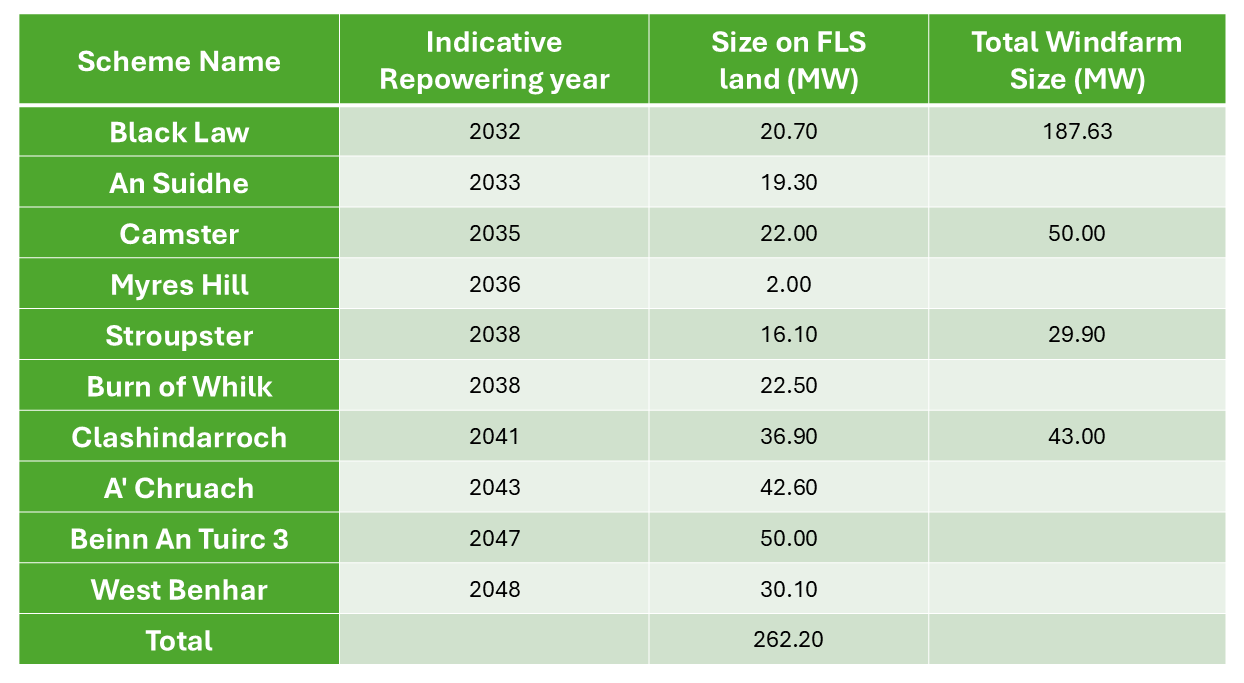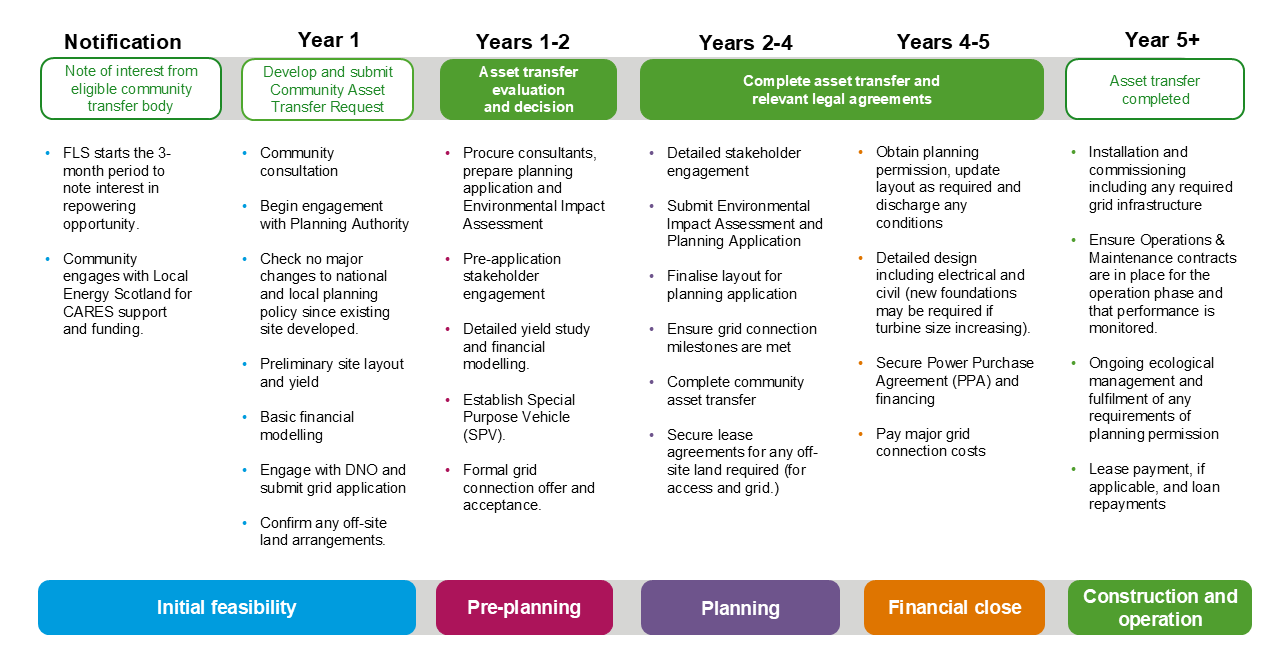Community Energy Opportunities with Forestry and Land Scotland
This pilot is an opportunity for community organisations and groups to develop onshore wind repowering projects on public land, primarily managed by Forestry and Land Scotland (FLS).
The project supports the Scottish Government’s goals to involve communities in the energy transition, particularly through community ownership of onshore renewable energy projects.
The timeline for projects will vary depending on when sites become available in different areas once their existing contracts have come to an end. Ten FLS onshore wind sites under 50 megawatts have been identified to pilot this approach.

This document lays out high-level guidance on how to develop a repowering project and the steps to make a successful asset transfer request to successfully progress a repowering opportunity.
What is Repowering?
Repowering a wind farm refers to the process of upgrading or replacing existing wind turbines at a site that has reached the end of its operational life, which is typically around 25 years. This process involves installing newer, more efficient turbines that can generate more electricity using the same or even fewer units.
Repowering helps extend the life of a wind farm, improve energy output and make better use of existing grid connections and land to produce low carbon energy.
Although on the same location, repowering sites are new applications and need to go through the necessary development and planning processes well in advance to ensure that they are designed effectively and to reduce the time between one project ending and the new one beginning.
Community Asset Transfer process
Community organisations have a legal right to request to take over publicly-owned land or buildings that they feel they can make better use of for local people under Part 5 Asset Transfer in the Community Empowerment (Scotland) Act 2015. These community empowerment rights apply to land owned or managed by public authorities which includes Forestry and Land Scotland. This presents an opportunity for communities to apply to lease or own land in order to build a community-owned wind farm as existing wind farms on FLS land approach the end of the lease agreements.
In order to apply for the right to own and operate wind turbines on FLS sites, community groups will need to submit an Asset Transfer Request. They need to demonstrate how their plan will help the community, and all requests must be conducted transparently with opportunities for public consultation.
Asset transfer legislation is designed to encourage and support ownership and control of public assets by communities in situations that recognise community benefits. It includes new rights for community organisations and places new responsibilities on public authorities. More information is available in the Asset Transfer Statutory Guidance for Community Transfer Bodies.
Local communities will be pre-notified of new renewable energy lease opportunities and given sufficient time, should they wish to prepare an asset transfer request. The pre-notification period will last for three months. Following pre-notification and prior to any commercial tendering, communities will have a 12-month period to submit a community asset transfer request.
Forestry and Land Scotland’s website explains how you can find out more information about the national forests and land which may be of use to your community. The website also has an updated list of relevant sites on public land, including the repowering window for those sites, and information on how community groups can apply for an Asset Transfer Request.
What is needed for a community to successfully develop a wind farm on public land?
Communities leasing public land to develop, own and operate a wind farm represents a long-term partnership over the land. To be successful, community organisations must have the right skills and experience and can put together a capable team.
Proposals will include clear evidence of experience and capability which can come from a combination of community members, contractors and partners. They will also include a detailed strategy for repowering the specific site, including timelines, grid and planning submissions, awareness of site constraints, and approach to secure funding.
It is important to minimise void time on sites which is the period between decommissioning wind turbines and re-energisation. Applicants must show how they will plan in advance to secure necessary agreements and co-ordinate with existing operators to ensure a smooth transition. This will minimise delays, loss of revenue and gaps in community income.
Good succession planning is also key, with potential partners expected to demonstrate how they will ensure the long-term success of the project through maintaining continuity and resilience throughout the project lifecycle.
In addition, demonstrating community support is a key requirement for making a valid asset transfer request. Applicants must outline how they will consult with the local community and other relevant stakeholders, ensuring there is transparency throughout the project and opportunities for feedback.
Windfarm development stages
Developing a wind farm is a journey and will be planned over several years. It will involve a team of technical, legal and financial advisors. It is important for community organisations to be aware of the different development stages of a wind farm.
The following is a high-level overview of the key stages involved in developing an onshore wind energy project, from feasibility to construction.
Key stages involved in developing an onshore wind energy project
For a visual representation of this overview, click the image below.
Options to benefit from renewables on FLS land
There are different community involvement models for community organisations to consider.
- Community Ownership
- The community leases or purchases the public land.
- The community develops, owns, and operates the wind farm entirely.
- All profits stay within the community.
- Requires significant financial, technical, and operational commitment.
If developing, owning, and operating the wind farm isn’t the right option for your community, it is worth seeing if you can partner with other local communities to increase capacity and bring in additional expertise.
- Progresses as a commercial project
If the site does not progress as a community owned project, Forestry and Land Scotland will advertise the site to commercial developers to bid for. Communities will still benefit from the project and should expect the following:
Community Benefits payments:
- The developer owns and operates the wind farm.
- The community receives a fixed payment or agreed benefits.
- No ownership or operational responsibility for the community.
- Some developers offer additional benefits, such as discounts on electricity used, or help with household energy-saving measures.
Shared Ownership opportunity:
- In addition to receiving community benefits, FLS requires the developer to offer the local community the opportunity to invest in and co-own the wind farm in partnership with the commercial developer.
- Profits and responsibilities are shared based on ownership percentage.
- Offers more involvement than benefits-only but less than full ownership.
Support available
There is support available through the Scottish Government’s Community and Renewable Energy Scheme (CARES) to help communities to get involved and benefit from the energy transition to net zero emissions. The scheme is administered and managed by Local Energy Scotland. CARES can help bring in additional expertise to support you through every stage of your wind farm repowering project, from development to construction and operation.
Local Energy Scotland’s team of local officers and energy specialists offer free and impartial advice to help communities develop their project from start to finish. They can also connect project leads with other community organisations that have been involved with renewable energy projects who will be able to share their expertise and lessons learned.
Community organisations should also be aware of the Community Ownership Support Service (COSS). This is a Scottish Government funded programme, set up to help community groups in Scotland take on assets for their community, giving them greater control of land and buildings, and helping to ensure local service delivery in the future. Support from COSS is free to access and they can help community organisations through the various stages of the asset transfer process.
Additional guidance resources:
A step-by-step guide for community bodies on asset transfer
For Communities – DTAS Community Ownership Support Service
Asset Transfer Statutory Guidance for Community Transfer Bodies
Forestry and Land Scotland guidance for community repowering
